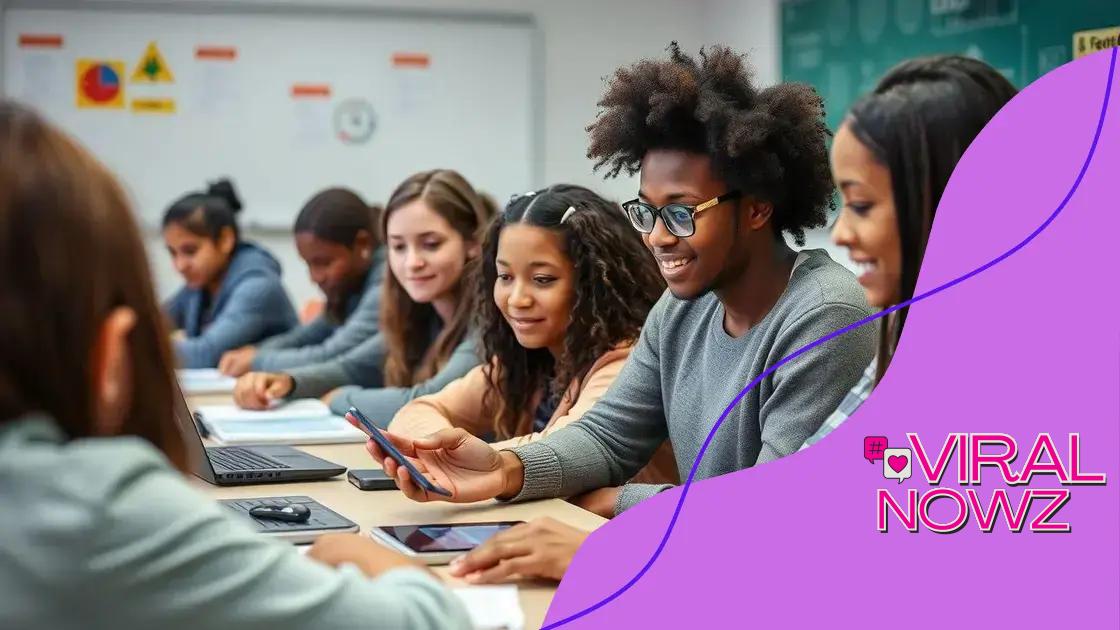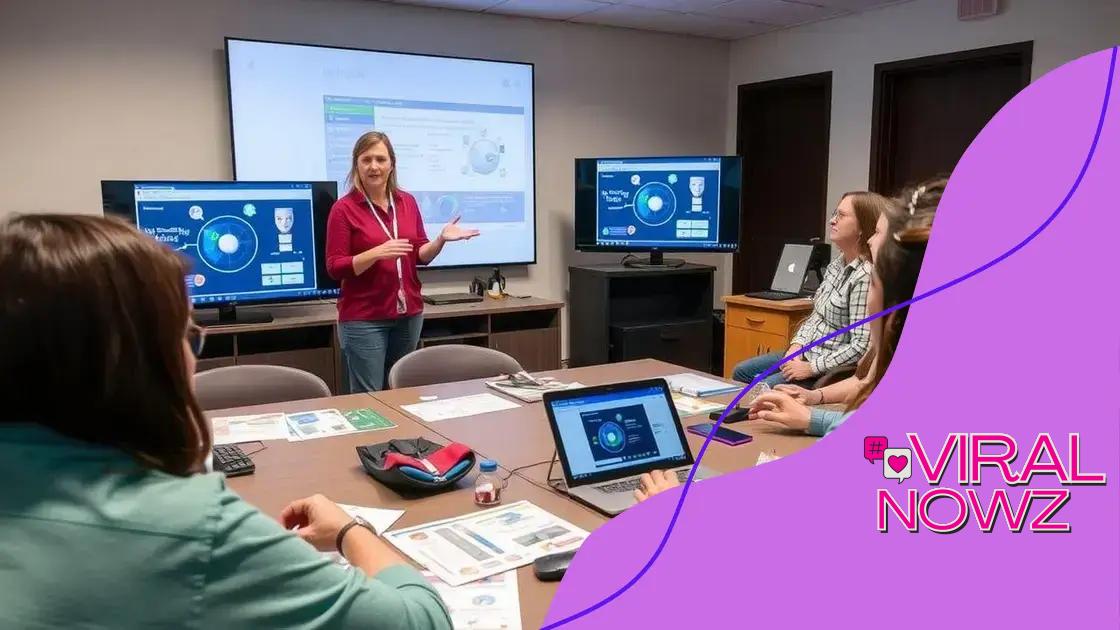AI-assisted tools for special education classrooms: unlocking potential

AI-assisted tools for special education classrooms enhance learning by providing personalized solutions, fostering engagement, and empowering students with unique needs to achieve their full potential.
AI-assisted tools for special education classrooms are changing the way educators approach teaching and learning. Have you ever wondered how technology can help bridge the gap for students with unique challenges? Let’s dive into this transformative trend and uncover its potential.
Understanding AI-assisted tools
Understanding AI-assisted tools can significantly impact how students learn in special education classrooms. These tools provide support tailored to each learner’s unique needs. By integrating technology into education, it ensures that every student has the opportunity to succeed.
What are AI-assisted tools?
AI-assisted tools refer to software and applications that utilize artificial intelligence to enhance learning experiences. They can analyze a student’s performance, offer personalized feedback, and adapt content to fit learning styles.
Key features of AI-assisted tools
- Personalization: Adapts learning modules to match individual student needs.
- Real-time feedback: Provides immediate responses, helping students understand concepts quickly.
- Data analysis: Tracks student progress and identifies areas needing improvement.
- Accessibility: Offers varied formats, ensuring all students can engage with the material.
Using these tools helps educators create a supportive environment. Students who may struggle in traditional settings often thrive with the assistance of technology. AI-assisted tools enable learners to explore at their own pace, making education more inclusive and effective.
For instance, a platform may offer speech-to-text capabilities. This feature allows those with writing difficulties to express their thoughts verbally. Visual learning aids, like interactive simulations, give students hands-on experiences crucial for their understanding. Overall, the incorporation of AI tools makes learning less daunting and more engaging for students with special needs.
Benefits for students with special needs
Benefits for students with special needs through AI-assisted tools are both significant and transformative. These tools provide customized support, making learning more accessible and effective. Each student can engage with materials in a way that suits their individual learning style.
Enhancing Engagement
AI-assisted tools promote greater student engagement. By using interactive elements, students feel more involved in their learning processes. This engagement often leads to increased motivation and a desire to learn.
Personalized Learning Experiences
Every learner is unique, and AI-assisted tools can adapt to their specific needs. For instance, they can modify the speed of lessons or present information in various formats. This means that students with different learning difficulties can grasp concepts at their own pace.
- Adaptable content that meets learning preferences.
- Focused areas for improvement through data analysis.
- Continuous feedback helps track progress.
- Encouragement of self-directed learning.
Moreover, these tools can assist educators in identifying strengths and challenges of each student. This ongoing analysis enables teachers to adjust their strategies effectively. The personalization offered by AI ensures that no student is left behind.
In addition to academic benefits, AI-assisted resources can enhance social skills. Many tools encourage collaboration through group activities. This helps students develop essential teamwork abilities while building friendships. With the right support, students with special needs can thrive just as well as their peers.
How educators can implement AI tools

How educators can implement AI tools in special education classrooms is a vital topic for enhancing learning outcomes. Using these tools effectively requires planning and understanding. With the right strategies, educators can make the most of technology to support their students.
Identify Needs and Goals
Before implementing AI tools, it’s important for educators to identify the specific needs of their students. Understanding each student’s strengths and challenges will guide the selection of suitable tools. Establishing clear educational goals helps focus the use of technology.
Selecting the Right AI Tools
Not all AI tools are created equal. Educators should look for tools that match their curriculum and fit the diverse needs of their students.
- Choose tools that provide real-time feedback.
- Look for customizable features to suit individual learning styles.
- Ensure the tools are accessible for all students.
- Consider tools with proven effectiveness in special education.
Once the right tools are selected, educators can begin the integration process. Training is essential. Teachers should familiarize themselves with the technology and explore various features ensured by these tools. Participating in workshops and professional development can build confidence in using AI.
Collaboration among educators is also critical. Sharing experiences and strategies can lead to better outcomes. When teachers discuss their successes and challenges, they can create a support network. Additionally, involving parents in the process is beneficial. Keeping them informed about the AI tools being used can help reinforce learning at home.
Monitoring progress is another essential element once AI tools are implemented. Educators should regularly assess how effective these tools are in enhancing student performance. Analyzing data can provide insights into each student’s progress and guide future instructional strategies.
Real-life success stories
Real-life success stories of students using AI-assisted tools in special education can inspire educators and families. These stories highlight the transformative impact of technology on learning and development.
Case Study: Alex’s Journey
One remarkable story is that of Alex, a student with dyslexia. Before using AI tools, Alex struggled with reading and often felt frustrated. However, after integrating a reading app that used speech recognition and interactive exercises, Alex began to engage more with texts. The app read aloud while highlighting words on the screen, enabling him to follow along. Soon, Alex’s reading skills improved significantly, boosting his confidence.
Collaborative Learning with Sam
Another example is Sam, who has autism and found communication challenging. With the help of AI technology, Sam used a communication app that allowed him to express his thoughts using pictures and words. This tool encouraged interaction with peers and teachers, leading to meaningful social connections. His classroom participation increased, and he began to form friendships, showcasing the importance of social development in education.
- Alex achieved better reading comprehension and confidence.
- Sam enhanced his communication skills and social interactions.
- Both students showed improved academic performance.
- Teachers observed increased engagement in class.
These experiences illustrate that AI tools do more than just assist academically. They also foster personal growth. Many students who struggled in traditional settings find a new sense of achievement through technology. The supportive features of AI-assisted tools provide valuable resources for both educators and learners. Every success story encourages the continued use of technology in special education, paving the way for future advancements.
Future trends in special education technology
Future trends in special education technology are evolving rapidly, and these advancements promise to enhance learning for students with special needs. As technology progresses, new tools will emerge that address various challenges faced by educators and students alike.
Adaptive Learning Technologies
One major trend is the growth of adaptive learning technologies. These tools will use data analytics to customize learning experiences for individual students. By continuously assessing a learner’s progress, these systems can adjust content and pace to fit their needs.
Augmented and Virtual Reality
Another exciting development is the use of augmented reality (AR) and virtual reality (VR) in classrooms. These immersive technologies can create engaging learning environments. For example, VR can simulate real-world scenarios that help students practice social skills or explore complex concepts in a hands-on way.
- AR can enhance traditional lessons by overlaying digital information on physical objects.
- VR can promote empathy by allowing students to experience different perspectives.
- These technologies make learning more interactive, increasing student engagement.
Additionally, the incorporation of AI-powered tools will grow. Machine learning algorithms will help track student performance trends and identify specific areas where support is needed. This proactive approach will allow educators to intervene early and provide personalized help.
Moreover, increased accessibility features in educational software will ensure that tools cater to all students, regardless of their disabilities. Voice recognition, text-to-speech, and customizable interfaces can significantly improve user engagement and facilitate learning. As these tools become more sophisticated, they will better support diverse learning needs.
Ultimately, the integration of emerging technologies into special education will create a more inclusive and effective learning environment. The future looks promising, as these advancements aim to empower students and help them achieve their fullest potential.
FAQ – Frequently Asked Questions about AI-assisted tools in special education
How can AI tools support students with special needs?
AI tools provide personalized learning experiences, adapting to individual student needs and helping them engage more effectively with educational materials.
What technologies are commonly used in special education?
Common technologies include adaptive learning platforms, speech recognition software, communication devices, and augmented/virtual reality tools that enhance learning and interaction.
How can educators effectively implement AI tools in their classrooms?
Educators should start by identifying student needs, selecting appropriate AI tools, and providing training to ensure effective use. Collaboration among teachers and involving parents is crucial for success.
What are the benefits of using AR and VR in special education?
AR and VR create immersive learning experiences, allowing students to practice skills in real-world scenarios, enhancing engagement and understanding of complex concepts.





